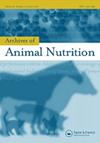Effect of dietary fibre and indigestible markers on the apparent total tract digestibility of gross energy and nutrients, and indigestible marker recovery in diets fed to growing pigs
IF 1.5
3区 农林科学
Q1 AGRICULTURE, DAIRY & ANIMAL SCIENCE
引用次数: 0
Abstract
ABSTRACT In this study, the effects of dietary fibre and types of indigestible markers (IM) on the apparent total tract digestibility (ATTD) of gross energy (GE) and nutrients as well as IM recovery in diets fed to growing pigs were investigated. A total of 30 barrows (initial body weight 40.5 ± 1.4 kg) were allotted to five experimental diets, based on a completely randomised block design, with body weight as a blocking factor. The five diets comprised a corn–soya bean meal basal diet, and four diets in which sugar beet pulp (SBP) or defatted rice bran (DFRB) partly replaced 10% or 20% of corn, soya bean meal and soya bean oil in the basal diet. All diets were formulated to contain two types of IM, namely 0.5% chromic oxide (Cr) and 1.0% celite as the source of acid-insoluble ash (AIA). Animals were subjected to a 7-d adaptation period, and their faeces were collected over a 5-d period using the total faecal collection (TC) method. Results showed that the AIA method determined similar ATTD of GE and nutrients as the TC method. Values of dietary nutrients determined via AIA and TC methods were significantly higher than those obtained by Cr (p < 0.05). The ATTD of GE and nutrients linearly decreased with an increased inclusion level of SBP or DFRB (p < 0.01), whereas recoveries of AIA and Cr were not affected by the aforementioned inclusions. Results from the faecal analysis revealed that AIA recovery (90.5%) was significantly higher than that of Cr (84.9%, p < 0.05), while diets with DFRB (91.3%) had significantly greater IM recovery rates than those with SBP (84.4%, p < 0.05). In conclusion, the type of dietary fibre, rather than the level, significantly affects IM recovery. Notably, AIA should be preferred to Cr when using the IM method to determine ATTD of GE and nutrients for diets in growing pigs.饲粮纤维和不消化指标对生长猪饲粮总能量和营养物质表观全消化道消化率及不消化指标回收率的影响
摘要本试验旨在研究饲粮纤维和不消化标记物(IM)类型对生长猪饲粮总能(GE)和营养物质表观全道消化率(ATTD)以及总能(IM)恢复的影响。试验采用完全随机区组设计,选取30头初始体重为40.5±1.4 kg的公驴,以体重为区组因素,分别饲喂5种试验饲粮。5种饲粮包括玉米-豆粕基础饲粮和4种饲粮,其中甜菜浆(SBP)或脱脂米糠(DFRB)部分替代基础饲粮中10%或20%的玉米、豆粕和豆油。所有饲粮均采用0.5%氧化铬(Cr)和1.0%天青石作为酸不溶性灰分(AIA)来源的两种IM。动物进行7 d的适应期,采用总粪便收集法(TC)收集5 d的粪便。结果表明,AIA法测定的GE和营养物质的ATTD与TC法相近。AIA法和TC法测定的饲粮营养物质值显著高于Cr法(p < 0.05)。GE和营养物质的ATTD随SBP和DFRB添加量的增加而线性降低(p < 0.01),而AIA和Cr的回收率不受上述添加量的影响。粪便分析结果显示,AIA回收率(90.5%)显著高于Cr (84.9%, p < 0.05),添加DFRB的IM回收率(91.3%)显著高于添加SBP的IM回收率(84.4%,p < 0.05)。综上所述,膳食纤维的种类,而不是水平,显著影响肠内纤维的恢复。值得注意的是,在使用IM法测定生长猪饲粮中GE和营养物质的ATTD时,AIA应优于Cr。
本文章由计算机程序翻译,如有差异,请以英文原文为准。
求助全文
约1分钟内获得全文
求助全文
来源期刊

Archives of Animal Nutrition
农林科学-奶制品与动物科学
CiteScore
3.90
自引率
5.00%
发文量
31
审稿时长
>24 weeks
期刊介绍:
Archives of Animal Nutrition is an international journal covering the biochemical and physiological basis of animal nutrition. Emphasis is laid on original papers on protein and amino acid metabolism, energy transformation, mineral metabolism, vitamin metabolism, nutritional effects on intestinal and body functions in combination with performance criteria, respectively. It furthermore deals with recent developments in practical animal feeding, feedstuff theory, mode of action of feed additives, feedstuff preservation and feedstuff processing. The spectrum covers all relevant animal species including food producing and companion animals, but not aquatic species.
Seldom can priority be given to papers covering more descriptive studies, even if they may be interesting and technically sound or of impact for animal production, or for topics of relevance for only particular regional conditions.
 求助内容:
求助内容: 应助结果提醒方式:
应助结果提醒方式:


